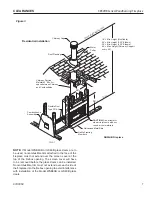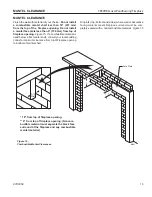
1
87D0058
SB50HB Series Woodburning Fireplace
The ability of insulating material to retard the transfer of
heat may be expressed as either Thermal Conductance (C),
Thermal Conductivity (K), or Thermal Resistance (R). The
mathematical relationship of these values and the formulas
for converting one value to another is as follows:
C=K divided by the material thickness
(Example C = .43 divided by 1/ (.50)
C = .86)
K = C multiplies by the material thickness
(Example K = .86 multiplied by 1/ (.50)
K = .43)
R= The material thickness divided by K
(Example R = 1/ (.50) divided by .43
R = 1.16)
FLOOr prOTeCTION
With either type hearth extension minor shifting of the sup-
porting floor or expansion and contraction may eventually
cause a crack to develop between the hearth extension and
the face of the fireplace. To help prevent the crack from
developing, the hearth extension materials must be firmly
fastened in place. Wall ties should be screwed to the face
of the fireplace and imbedded in the mortar joints of brick,
stone, or other non-combustible materials. The metal safety
59”
30”
58”
28
56O
”
20”
74”
FP2223
hearth protection
Figure 13
Metal Safety Strip
Combustible
Floor
FP3
Hearth
Protection
WarNINg:
The hearth extension and the
metal safety strip should be installed only
in a horizontal relationship to the fireplace.
12”
Min.
12”
Min.
20” Min.
FP2224
hearth ext front
Top of Raised Hearth
Floor Line with
Raised Hearth
Hearth
Extensions
Metal Safety
Strip
Figure 14
FP4
strip packed with the fireplace must be placed beneath
the fireplace and extended under the hearth extension
or into a mortar joint of the hearth extension as shown by
Figures 10, 13, and 14
. In the event a crack does eventu-
ally develop, the metal safety strip will serve as a barrier
to prevent sparks or embers from falling from the fireplace
onto combustible flooring materials.













































